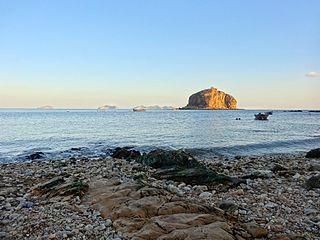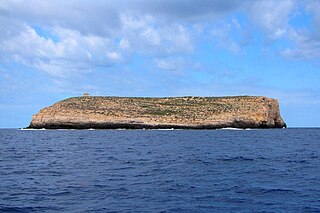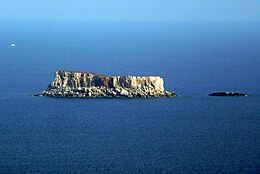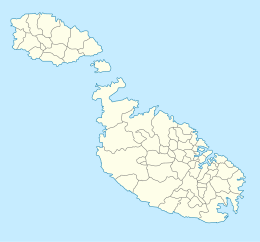
The geography of Malta is dominated by water. Malta is an archipelago of coralline limestone, located in Europe, in the Mediterranean Sea, 81 kilometres south of Sicily, Italy, and nearly 300 km north (Libya) and northeast (Tunisia) of Africa. Although Malta is situated in Southern Europe, it is located farther south than Tunis, capital of Tunisia, Algiers, capital of Algeria, Tangier in Morocco and also Aleppo in Syria, and Mosul in Iraq in the Middle East. Only the three largest islands – Malta, Gozo and Comino – are inhabited. Other (uninhabited) islands are: Cominotto, Filfla and the St.Paul's Islands. The country is approximately 316 km2 in area. Numerous bays along the indented coastline of the islands provide harbours. The landscape of the islands is characterised by high hills with terraced fields. The highest point, at 253 metres, Ta' Zuta on mainland Malta. The capital is Valletta.

Valletta is the capital city of Malta and one of its 68 council areas. Located between the Grand Harbour to the east and Marsamxett Harbour to the west, its population as of 2021 was 5,157. As Malta’s capital city, it is a commercial centre for shopping, bars, dining, and café life. It is also the southernmost capital of Europe, and at just 0.61 square kilometres (0.24 sq mi), it is the European Union's smallest capital city.

An islet is a very small, often unnamed island. Most definitions are not precise, but some suggest that an islet has little or no vegetation and cannot support human habitation. It may be made of rock, sand and/or hard coral; may be permanent or tidal ; and may exist in the sea, lakes, rivers or any other sizeable bodies of water.

The Savage Islands or Selvagens Islands are a small Portuguese archipelago in the North Atlantic Ocean, 280 kilometres (175 mi) south of Madeira, and 165 kilometres (105 mi) north of the Canary Islands. The archipelago includes two major islands, Selvagem Grande and Selvagem Pequena, each surrounded by a cluster of islets and reefs, with the total area of 2.73 km2 (1.05 sq mi). The archipelago is administered as part of the Portuguese municipality of Funchal, belongs to the Madeiran civil parish of Sé, and is the southernmost point of Portugal.

Comino is a small island of the Maltese archipelago between the islands of Malta and Gozo in the Mediterranean Sea, measuring 3.5 square kilometres (1.4 sq mi) in area. Named after the cumin seed, the island has a permanent population of only two residents and is part of the municipality of Għajnsielem, in southeastern Gozo, from where one priest and one policeman commute. The island is a bird sanctuary and nature reserve.

Lively Island is the largest of the Lively Island Group of the Falkland Islands, The island group lies east of East Falkland. Lively Island is the largest rat-free island in the Falklands, hence its importance to birdlife. The island also has a sheep farm.

Għarb is an administrative unit of Malta, located at the westernmost point of the island of Gozo, with a population of 1,539 people.

Fungus Rock, sometimes known as Mushroom Rock, and among the Maltese as Il-Ġebla tal-Ġeneral, is a small islet in the form of a 60-metre-high (200 ft) massive lump of limestone at the entrance to an almost circular black lagoon in Dwejra, on the coast of Gozo, itself an island in the Maltese archipelago. It is located at 36°02′45″N14°11′27″E and falls within the jurisdiction of the town of San Lawrenz.

St Paul's Island, also known as Selmunett, is a small island off Selmun, Mellieħa near the north of the island of Malta. St Paul's Island is sometimes split into two islands by a shallow isthmus, and it is therefore sometimes referred to in the plural as St Paul's Islands. St Paul's Island has been uninhabited since World War II, and it is the second largest uninhabited island of Malta, having an area of 0.1 square kilometres.

Nightingale Island is an active volcanic island in the South Atlantic Ocean, 3 square kilometres (1.2 sq mi) in area, part of the Tristan da Cunha group of islands. They are administered by the United Kingdom as part of the overseas territory of Saint Helena, Ascension and Tristan da Cunha.

Qrendi is a village in the Southern Region of Malta, with a population of 3148 people as of October 2021. It is located close to Mqabba, Żurrieq and Siggiewi. Within its boundaries are two well-known Neolithic temples called Mnajdra and Ħaġar Qim. In this village two feasts are held annually. The feast of Our Lady of Lourdes is celebrated either on the last Sunday of June or on the first Sunday of July, with 15 August the titular feast of the Ascension of Our Lady. This feast is popularly known as the feast of Santa Maria.

Lampione is a small rocky island located in the Mediterranean Sea, which belongs geographically to the Pelagie Islands and administratively to the comune of Lampedusa e Linosa, Province of Agrigento, region of Sicily, Italy. It is about 200 metres long and 180 metres across, and has an area of 4 hectares and a highest elevation of 36 metres.

The common diving petrel , also known as the smaller diving petrel or simply the diving petrel, is a diving petrel, one of four very similar auk-like small petrels of the southern oceans. It is native to South Atlantic islands and islands of the subantarctic southern Indian Ocean, islands and islets off New Zealand and south-eastern Australian islands.

The filfola lizard or Maltese wall lizard is a species of lizard in the family Lacertidae. It is found in Italy and in the island group of Malta. Its natural habitats are Mediterranean-type shrubby vegetation, rocky areas, rocky shores, arable land, pastureland, and rural gardens.

The Nuyts Archipelago is an island group located in South Australia in the Great Australian Bight to the south of the town of Ceduna on the west coast of the Eyre Peninsula. It consisting of mostly granitic islands and reefs that provide breeding sites for Australian sea lions and support colonies of short-tailed shearwater. It also includes the island group known as the Isles of St Francis. All the islands with exception of a part of Evans Island, are located within the following protected areas: the Nuyts Archipelago Wilderness Protection Area and the Nuyts Archipelago Conservation Park.

The Chapel of St Matthew, popularly known as San Mattew Iż-Żgħir, literally meaning Saint Matthew the smaller, is a small medieval chapel located beside a larger church with the same name in an area known as il-Maqluba in Qrendi, Malta. The use of the word the smaller is used that one would not confuse it with the larger St Matthew's church.

Ħalfa Rock(Maltese: Il-Ġebla tal-Ħalfaor Il-Blata tal-Ħalfa) is a deserted small islet and limestone rock on the south-east coast of the island of Gozo in the Maltese archipelago. The small islet is typified by a small maritime labiate garrigue environment, with germander and prasium shrubs, with the occurrence of the endemic Maltese Pyramidal Orchid as well as endemic coastal communities based on the Maltese Sea-Lavender and the sub-endemic Maltese Crosswort.

Il-Maqluba is a sinkhole with a surface area of around 4,765 square metres (51,290 sq ft) situated in the village of Qrendi in Malta. Il-Maqluba is a Special Area of Conservation – Candidate Site of International Importance and designated as a Tree Protection Area, forming part of Natura 2000 sites, a network of nature protection areas within the European Union, also earning the European Destination of Excellence title bestowed onto the locality by the European Union's Commission for Tourism.

Praia Islet is a highly vegetated uninhabited islet located approximately 1.5 kilometres away from the town of Praia off the eastern coast of the island of Graciosa in the Portuguese archipelago of the Azores. Along with Baixo Islet to its south, Praia Islet is one of two main breeding places of Monteiro's storm petrel, an endemic marine bird of the Azores.

The Comino Police Station is the only operating police station located on the small island of Comino in the Maltese Archipelago, on the coast of the Santa Marija Bay, 152 metres (499 ft) north of the Comino Chapel.






















